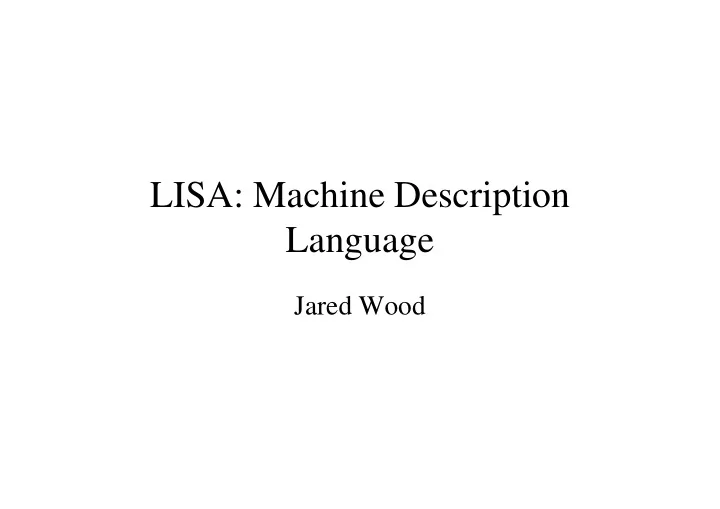

LISA: Machine Description Language Language Jared Wood
Outline • LISA – Motivation – Description – Description – Machine model • Requirements • Operation sequencer – L-charts
LISA: Motivation • Accurate machine model – Bit- & cycle-/phase-accuracy • Models: • Models: – ISA for compilers & instruction-set simulators • Too rough – HW design • Too detailed • LISA: cover gap between models
LISA: Motivation • Behavioral pipeline modeling – Pipeline controller for generic machine model – Parameterized by – Parameterized by • Precedence constraints • Resource constraints
LISA: Description • Operation-level description of pipeline • Operations: register transfers during single control step control step • Instructions: set of operations • Control step: – Instruction-cycle – Clock-cycle – Phase-cycle
LISA: Description • Operation scheduling � L-Charts – Specify: • Time and resource allocation • Time and resource allocation • Operation sequencer w/ ASAP strategy • Goal: – Single generic machine model – Single generic description language
LISA: Description • Main applications so far: – Timed ISA simulation for HW/SW co-design • Other possibility: • Other possibility: – Compilation
LISA: Description behavior Select/schedule compiler instructions Scheduled behavior simulator instructions
Machine Model: Requirements • Application domain: – RT SW design – DSP/embedded system design – DSP/embedded system design – HW/SW co-verification – Architecture exploration
Machine Model: Requirements • Processor class: – DSPs & microcontrollers • Low or medium complexity • Low or medium complexity • Pipelined, VLIW, & RISC architectures
Machine Model: Requirements • Model accuracy: – Timing: • Instruction, clock, or phase – Bit-accurate register transfers – Bit-accurate register transfers – Exact state modeling: • Pipeline, interrupt, & wait – Spatial accuracy: • SW-level: registers, memory • System-level: interrupts, peripherals • HW-level: pins – Control step state visibility
Machine Model: Operation Sequencer • At control step t: – Admissible operations determined • Based on precedence & resource constraints • Based on precedence & resource constraints – Transition function Ft formed – Ft applied to machine – Machine state changes
Machine Model: Operation Sequencer Instruction n-1 {O1,O2,O3} Instruction n {P1,P2,P3} Instruction n+1 {Q1,Q2,Q3}
Machine Model: Operation Sequencer Instruction n-1 {O1,O2,O3} precedence Instruction n {P1,P2,P3} Instruction n+1 {Q1,Q2,Q3}
Machine Model: Operation Sequencer Instruction n-1 {O1,O2,O3} Instruction n sequencer {P1,P2,P3} Instruction n+1 {Q1,Q2,Q3}
Machine Model: Operation Sequencer rules Instruction n-1 {O1,O2,O3} Admissible Admissible operations Instruction n sequencer {P1,P2,P3} Ft = {O3,P2,Q1} Instruction n+1 {Q1,Q2,Q3}
L-Charts • Extended Gantt chart – Change time axis to precedence axis
L-Charts precedence R0: O1 R1: O2 R2: O3 R0: P1 R1: P2 P3 R2: P4 R0: Q1 R1: R2: Q2
L-Charts precedence R0: O1 R1: O2 R2: O3 R0: P1 sequencer R1: P2 P3 R2: P4 R0: Q1 R1: R2: Q2
L-Charts precedence R0: O1 R1: O2 R2: O3 R0: O1 R0: O1 R0: P1 R1: sequencer R1: P2 P3 R2: R2: P4 R0: Q1 R1: R2: Q2
L-Charts precedence R0: O1 R1: O2 R2: O3 R0: O1 P1 R0: O1 P1 R0: P1 R1: O2 sequencer R1: P2 P3 R2: R2: P4 R0: Q1 R1: R2: Q2
L-Charts precedence R0: O1 R1: O2 R2: O3 R0: O1 P1 Q1 R0: O1 P1 Q1 R0: P1 R1: O2 P2 sequencer R1: P2 P3 R2: O3 R2: P4 R0: Q1 R1: R2: Q2
L-Charts precedence R0: O1 R1: O2 R2: O3 R0: O1 P1 Q1 R0: O1 P1 Q1 R0: P1 R1: O2 P2 P3 sequencer R1: P2 P3 R2: O3 P4 R2: P4 R0: Q1 R1: R2: Q2
L-Charts precedence R0: O1 R1: O2 R2: O3 R0: O1 P1 Q1 R0: O1 P1 Q1 R0: P1 R1: O2 P2 P3 sequencer R1: P2 P3 R2: O3 P4 Q2 R2: P4 R0: Q1 R1: R2: Q2
L-Charts • LISA expressed more compactly O1(R1) | O2(R2) | O3(R2) | O4(R3),O5(R4) | O6(R4)
L-Charts • LISA expressed more compactly O1(R1) | O2(R2) | O3(R2) | O4(R3),O5(R4) | O6(R4) | � precedence , � parallelism ( ) � resource
L-Charts • LISA expressed more compactly O1(R1) | O2(R2) | O3(R2) | O4(R3),O5(R4) | O6(R4) No precedence | � precedence , � parallelism ( ) � resource
L-Charts • Pipelined architecture – 3 types of hazards • Structural: resource conflicts • Data: data grabbed before update • Data: data grabbed before update • Control: conflict assigning proper control step – Must be detected & resolved • Gantt � naturally covers structural • Operations accessing resource must specify R/W • Access must be announced in advance
L-Charts • Additional extension • Hazard scenario Instruction 1: IF | ID(!w:R0) | IA | ID(w:R0) | Instruction 2: IF | ID(r:R0) | IA | IE
L-Charts • Additional extension • Hazard scenario Instruction 1: IF | ID(!w:R0) | IA | ID(w:R0) | Instruction 2: IF | ID(r:R0) | IA | IE Data hazard not admissible
L-Charts • Additional extension • Hazard scenario Instruction 1: IF | ID(!w:R0) | IA | ID(w:R0) | Instruction 2: IF | nop | nop | ID(r:R0) | IA | IE
L-Charts • Pipeline flow delayed only for resource conflicts • Processors w/ out-of-order executions • Processors w/ out-of-order executions excluded – No superscalar processors – Instuction n checked with instruction n-1
Conclusion • Main contribution of LISA – L-charts • Extend Gantt charts to handle data/control hazards • Mainly used in simulation • Mainly used in simulation • Capable to use in compilation • Aimed at – low/medium complexity machine • DSP/embedded system – HW/SW co-design
Recommend
More recommend